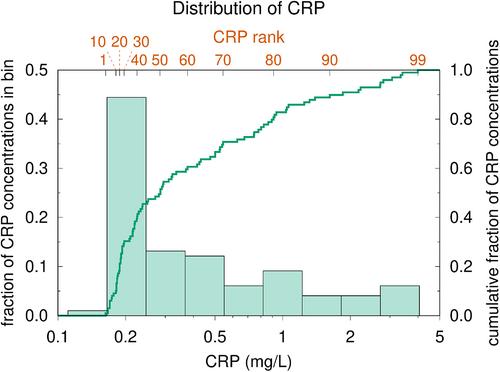In non-industrialized and low-income populations, adipose stores can serve as a valuable buffer against harsh conditions such as seasonal food scarcity. However, these reserves may incur costs due to adipocytes' production of pro-inflammatory cytokines; inflammation is associated with increased risk for cardiometabolic diseases later in life. Life history theory posits that, especially in populations with high juvenile mortality, higher adiposity may nonetheless be advantageous if its benefits in early life outweigh its later costs. Relatively little is known about adolescents' C-reactive protein concentration (CRP; an inflammation biomarker) in such environments. We investigated CRP and its associations with several hypothesized predictors in adolescents in an economically diverse peri-urban Andean community.
We measured CRP in dried blood spots and collected data on anthropometrics, illnesses, socioeconomic status (SES), and menarcheal status in 59 female and 40 male adolescents (“Alteños”, 11.0–14.9 years old) with normal vital signs in El Alto, Bolivia (~4150 m amsl). We used Cole's LMS method to standardize all anthropometrics for sex and age, and principal components analysis to construct a “fat-factor” variable loading on these standardized z-scores. We used multiple linear regression to assess the influence of fat-factor and other likely predictors on CRP rank.
Compared to a national Bolivian growth reference, Alteños were, on average, shorter and leaner; only 6% were classified as overweight and none were obese. Pre-menarche females were on average leaner than post-menarche females. The best-fitting model explained 24% of the variance in CRP rank. Significant predictors were fat-factor, SES, current illness for males and pre-menarche females, and z-height for females.
Our results are consistent with a tradeoff between investments in growth versus immune functioning, as might be expected in an environment with limited resources and high pathogen exposure (e.g., soil-transmitted helminths, poor sanitation). Thinner Alteños appear to maintain a minimum CRP concentration independent of fat-factor, while fatter (or less-thin) Alteños' CRP rises with fat-factor. Female Alteños appear to be trading off investment in immune response for investment in growth and maturation. Alteños' high rate of stunting and absence of obesity suggests chronic, presumably multifactorial, stress. Adipose stores likely buffer against some of these stressors and, in an environment such as this—in which many lack sufficient nutritious foods, potable water, adequate sewage, and health care—may confer a net lifetime benefit.


